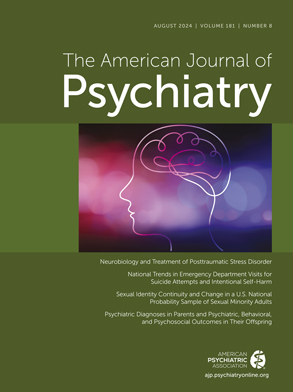To the Editor:
I applaud Dr. Mayou et al. for questioning the validity of the diagnosis of somatoform disorders. It has never been a clinically useful classification. I question, however, the suggestion that 25%–50% of the patients seen by primary and secondary care physicians with somatic symptoms that are unexplained by a general medical condition should be classified on axis III of DSM. DSM is, after all, a psychiatric classification. Should these tens of millions of patients be assumed to have a psychiatric disorder because we cannot clearly define their complaints?
The authors stated that patients fitting the descriptors “somatoform disorder,” “functional somatic syndrome,” and “medically unexplained symptoms” (used interchangeably in the article) “lie in an ambiguous area of medical thinking somewhere between medicine and psychiatry” (p. 847). This statement is unproven. It assumes the following:
That patients with symptoms that are not diagnosable with current medical technology are psychologically different from those with a clear diagnosis
That patients who are not diagnosable with current paradigms should be classified with DSM (a psychiatric classification)
That current paradigms are complete and unflawed and thus patients not fitting these paradigms must be in the psychosomatic gray zone
I remember my confusion during medical school psychiatry training when told that some psychoses were “functional” and some were “organic.” I could not understand how behavior, feelings, and thoughts could be so affected without some measurable change in cellular or subcellular function. Did our crude technology, unable to discern pathology, mean that it did not exist? Now that we have the tools (computerized tomography, functional magnetic resonance imaging, positron emission spectroscopy, single photon emission computed tomography, receptor binding ligands), we can measure changes in people with psychoses, and the organic/functional polarity has moved to the background. If one studies medical history, one will note that as diagnostic technology improves, fewer and fewer disorders are categorized as “psychosomatic” or “functional.” DSM has aided in this progress by defining disorders more precisely (e.g., schizophrenic versus bipolar psychosis) so that homogeneous groups can be studied. Consider a study designed to include the huge heterogeneous group encompassed by the term “medically unexplained symptoms.” What would be the chance of any clear finding? What organ would be studied? This mixing of diverse patients is a recipe to avoid finding anything clinically useful.
The central hypothesis of the article by Dr. Mayou et al. that the understanding and classification of somatoform disorders should be changed is valid. But the suggested solution of classifying one-quarter to one-half of all medical attenders as having a somatoform disorder (or any of its synonyms) is faulty. I would suggest instead to narrow the rubric of “somatoform disorders” to include only the few severely dysfunctional patients in whom acknowledging feelings is too painful and whose physical symptoms can be shown to result in lieu of direct emotional expression. For the majority of patients with “somatic symptoms unexplained by a general medical condition,” we should continue to refine the medical categories that are already in use until there is solid evidence to suggest a better alternative.

